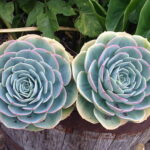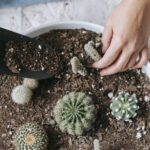
Indoor or Outdoor: Maximizing Succulent Growth for Optimal Results

Succulents have become increasingly popular in recent years, with their unique and visually appealing forms capturing the attention of plant enthusiasts around the world. These plants are known for their ability to store water in their leaves, stems, and roots, enabling them to survive in arid conditions. While succulents are often associated with being low-maintenance, there are certain factors that can greatly impact their growth and overall health. One of the key considerations for succulent care is whether they should be grown indoors or outdoors, as each environment offers its own advantages and challenges.
We will explore the pros and cons of growing succulents both indoors and outdoors. We will discuss the ideal growing conditions for succulents, including the amount of sunlight, temperature, and humidity they require. Additionally, we will provide practical tips and advice on how to maximize succulent growth and ensure optimal results, whether you choose to cultivate them indoors or outdoors. By the end of this article, you will have a better understanding of how to create the perfect environment for your succulents and help them thrive.
- Provide succulents with adequate sunlight by placing them near a sunny window or using grow lights
- Use well-draining soil specifically formulated for succulents to prevent root rot
- Water succulents sparingly, allowing the soil to completely dry out between waterings
- Avoid overwatering by using a spray bottle or watering can with a narrow spout to target the soil directly
- Protect succulents from extreme temperatures by bringing them indoors during cold winters or hot summers
- Rotate succulents regularly to ensure even growth and prevent them from leaning towards the light source
- Fertilize succulents with a balanced, low-nitrogen fertilizer during the growing season
- Remove dead leaves and trim leggy growth to promote a compact and healthy appearance
- Repot succulents every 1-2 years to refresh the soil and provide more space for root growth
- Keep an eye out for pests such as mealybugs or spider mites and take appropriate measures to control them
- Frequently Asked Questions
Provide succulents with adequate sunlight by placing them near a sunny window or using grow lights
Succulents are known for their ability to thrive in sunny and dry conditions. To ensure optimal growth, it is important to provide them with adequate sunlight.
One way to do this is by placing your succulents near a sunny window. Choose a window that receives at least 6 hours of direct sunlight per day. This will provide the necessary light for your succulents to photosynthesize and grow.
If you don't have access to a sunny window or if the available sunlight is insufficient, you can use grow lights to supplement the light your succulents receive. LED grow lights are particularly effective as they provide the right spectrum of light needed for succulent growth. Position the lights about 6-12 inches above your succulents and keep them on for 12-14 hours a day to mimic natural sunlight.
Remember, while succulents love sunlight, it's important to avoid exposing them to intense, direct sunlight for extended periods, especially during the hottest parts of the day. This can cause sunburn and damage the leaves.
Water succulents sparingly to prevent root rot
 Growing Curly Jade Succulents Indoors: Tips and Advice
Growing Curly Jade Succulents Indoors: Tips and AdviceOne of the most common mistakes people make when caring for succulents is overwatering. Succulents have adapted to survive in arid climates by storing water in their leaves, stems, and roots. Therefore, they have a low tolerance for excessive moisture.
When watering your succulents, it's crucial to follow the "soak and dry" method. This means thoroughly watering the soil until water drains out of the drainage holes, and then allowing the soil to dry out completely before watering again. Depending on the climate and the specific succulent, this may range from once a week to once every few weeks.
It's important to use well-draining soil specifically formulated for succulents to prevent water from pooling around the roots. You can also add perlite or pumice to improve drainage. Remember, succulents are more likely to survive underwatered than overwatered.
Provide adequate airflow and ventilation for healthy succulents
Succulents thrive in environments with good airflow and ventilation. Proper airflow helps prevent the growth of mold, fungus, and pests, which can be detrimental to succulent health.
When displaying your succulents indoors, avoid overcrowding them. Leave enough space between plants to allow for air circulation. This will also prevent the spread of diseases if one succulent becomes infected.
If you notice any signs of poor airflow, such as leaves becoming mushy or discolored, consider using a small fan or opening windows to improve ventilation. However, be cautious of exposing your succulents to drafts or extreme temperature changes, as they prefer stable conditions.
 Can a Mother of Millions Succulent Thrive Indoors?
Can a Mother of Millions Succulent Thrive Indoors?Fertilize succulents sparingly to avoid overfeeding
Succulents are relatively low-maintenance plants when it comes to fertilizing. They are adapted to nutrient-poor soils and can thrive without frequent feeding. In fact, overfertilizing can be harmful and lead to succulent damage.
It is recommended to fertilize your succulents sparingly, typically during the active growing season, which is spring and summer. Use a balanced, water-soluble fertilizer diluted to half strength. Apply the fertilizer once a month or less, following the instructions on the packaging.
Remember, it's always better to underfeed your succulents than to overfeed them. Excessive fertilization can cause nutrient burn, leading to burnt and discolored leaves, as well as weak and leggy growth.
Protect succulents from extreme temperatures and frost
Succulents are generally hardy plants, but they do have limits when it comes to temperature extremes. Most succulents prefer temperatures between 60°F and 80°F (15°C and 27°C). However, they can tolerate slightly higher or lower temperatures for short periods.
If you live in an area with harsh winters, it's important to protect your succulents from freezing temperatures and frost. Move them indoors or provide them with a frost cover or protective shelter. Frost can damage the cells of succulents, causing them to become soft, mushy, and eventually die.
 Can Red Rose Succulents Thrive Indoors?
Can Red Rose Succulents Thrive Indoors?On the other hand, extreme heat can also be detrimental to succulent health. If you live in a hot climate, provide your succulents with shade during the hottest parts of the day or move them to a cooler spot. Avoid placing them in direct sunlight during peak temperatures, as this can lead to sunburn.
Use well-draining soil specifically formulated for succulents to prevent root rot
When it comes to growing succulents, one of the most important factors to consider is the type of soil you use. Succulents require well-draining soil to prevent their roots from sitting in water for too long, which can lead to root rot. To ensure optimal growth and prevent any potential damage to your succulents, it is recommended to use a well-draining soil specifically formulated for succulents.
This type of soil is typically made up of a combination of materials such as sand, perlite, and gravel. These components help create air pockets within the soil, allowing excess water to drain away quickly. As a result, the roots of your succulents will be able to access the water they need without being overly saturated.
It is important to note that regular potting soil is not suitable for succulents as it retains moisture for longer periods, increasing the risk of root rot. Using a well-draining soil specifically formulated for succulents will provide the ideal growing conditions for these plants.
When choosing a well-draining soil for your succulents, look for products labeled as "cactus mix" or "succulent soil." These are readily available at most garden centers or can be purchased online. Additionally, you can also create your own well-draining soil mix by combining equal parts of sand, perlite, and potting soil.
Remember, the right soil is crucial for the health of your succulents. By using a well-draining soil specifically formulated for succulents, you can prevent root rot and provide the optimal growing conditions for your plants.
Water succulents sparingly, allowing the soil to completely dry out between waterings
 Can Crassula Flapjack Succulent Thrive and Flourish Indoors?
Can Crassula Flapjack Succulent Thrive and Flourish Indoors?One of the most important factors in maximizing succulent growth is proper watering. Succulents are known for their ability to store water in their leaves and stems, making them highly adapted to survive in arid environments. Therefore, it is crucial to water succulents sparingly to prevent overwatering, which can lead to root rot and other issues.
When it comes to watering succulents, the key is to allow the soil to completely dry out between waterings. This will mimic their natural habitat and prevent the roots from sitting in wet soil for extended periods of time. Overwatering can cause the roots to rot and ultimately kill the plant.
To determine when to water your succulents, it's best to use the "soak and dry" method. This means thoroughly watering the soil until water drains out of the bottom of the pot and then waiting for the soil to dry out completely before watering again. Depending on the climate and the type of succulent, this may range from every 2-4 weeks.
It's important to note that different succulent varieties have different water requirements. Some succulents, like Echeverias and Haworthias, prefer less frequent watering, while others, like Sedums and Crassulas, can tolerate more frequent watering. Understanding the specific needs of your succulents will help you determine the appropriate watering schedule.
Additionally, it's crucial to use well-draining soil for your succulents. Regular potting soil is too moisture-retentive and can lead to root rot. Instead, opt for a succulent or cactus mix, which is specifically formulated to provide the proper drainage that succulents need.
Watering succulents sparingly and allowing the soil to completely dry out between waterings is essential for maximizing their growth. By following the "soak and dry" method and using well-draining soil, you can ensure optimal results and keep your succulents thriving.
Avoid overwatering by using a spray bottle or watering can with a narrow spout to target the soil directly
When it comes to succulent care, one of the most common mistakes is overwatering. Succulents have adapted to survive in arid environments by storing water in their leaves and stems, making them more prone to rot if they sit in damp soil for too long. To avoid this, it is best to water succulents sparingly and directly target the soil.
 Can Succulents Thrive Outdoors with Minimal Care?
Can Succulents Thrive Outdoors with Minimal Care?A great way to achieve this is by using a spray bottle or a watering can with a narrow spout. This allows you to control the amount of water you apply and ensures that it reaches the soil directly without drenching the entire plant. When watering your succulents, make sure to moisten the soil evenly, but avoid saturating it.
Another important tip is to water your succulents only when the soil is completely dry. Overwatering can lead to root rot and other diseases that can harm your plants. To check if it's time to water, insert your finger about an inch into the soil. If it feels dry, it's time to water your succulents.
It's worth noting that the watering needs of succulents can vary depending on whether they are kept indoors or outdoors. Indoor succulents are generally less exposed to direct sunlight and have more controlled environments, which means they require less water compared to their outdoor counterparts.
When it comes to indoor succulents, it's best to water them every 10-14 days, allowing the soil to dry out between waterings. This prevents the roots from sitting in overly moist soil for extended periods. Make sure to adjust the watering frequency based on your specific indoor conditions, such as the humidity level and the amount of sunlight your succulents receive.
On the other hand, outdoor succulents may require more frequent watering due to the exposure to direct sunlight and higher temperatures. In hot and dry climates, succulents may need to be watered every 5-7 days, or even more frequently during heatwaves. Again, it's crucial to monitor the soil moisture and adjust the watering schedule accordingly.
Remember, succulents are resilient plants, and they can tolerate periods of drought better than excessive moisture. By using the right watering techniques and adjusting them based on your succulent's environment, you can ensure optimal growth and prevent common issues associated with overwatering.
Protect succulents from extreme temperatures by bringing them indoors during cold winters or hot summers
 Indoor Succulent Gardening: Best Tall Succulents for Thriving Indoors
Indoor Succulent Gardening: Best Tall Succulents for Thriving IndoorsSucculents are known for their ability to thrive in arid conditions, but extreme temperatures can still pose a threat to their growth. Whether you live in a region with harsh winters or scorching summers, it's important to protect your succulents by bringing them indoors during these challenging seasons.
During cold winters, succulents are susceptible to frost damage, which can cause their leaves to become discolored, mushy, or even fall off. To prevent this, it's best to bring your succulents indoors when temperatures start to drop below freezing. Find a bright spot near a window where they can receive adequate sunlight.
On the other hand, hot summers can also be detrimental to succulents, especially if they are exposed to direct sunlight for prolonged periods. The intense heat can cause their leaves to shrivel up, become scorched, or even burn. In such cases, it's advisable to provide your succulents with some shade or bring them inside where the temperature is more controlled.
When transitioning your succulents indoors, it's important to consider their specific needs. Here are some key points to keep in mind:
Lighting:
Succulents require ample sunlight to thrive. Choose a well-lit area near a window where they can receive at least six hours of indirect sunlight per day. If natural light is limited, you can supplement it with artificial grow lights.
Temperature:
Indoor temperatures between 60-75°F (15-24°C) are usually ideal for most succulents. Avoid placing them near drafts or heating vents, as sudden temperature fluctuations can stress the plants.
Watering:
While succulents are known for their ability to store water in their leaves and stems, it's important not to overwater them. Allow the soil to dry out between waterings, and make sure the pot has good drainage to prevent root rot.
 Succulents: Indoor or Outdoor Plants?
Succulents: Indoor or Outdoor Plants?Humidity:
Succulents prefer low humidity levels, so avoid placing them in areas with high moisture, such as bathrooms. If the air in your home is too dry, you can increase humidity by placing a tray of water near the plants or using a humidifier.
By bringing your succulents indoors during extreme temperatures, you can ensure their optimal growth and prevent any potential damage. Remember to monitor their needs closely and make adjustments as necessary. With the right care, your indoor succulent garden will thrive and bring beauty to your home all year round.
Rotate succulents regularly to ensure even growth and prevent them from leaning towards the light source
Succulents are known for their ability to thrive in various environments, whether it be indoors or outdoors. However, to achieve optimal results and maximize their growth, it is important to provide them with the right conditions. One simple but effective method to ensure even growth and prevent succulents from leaning towards the light source is by regularly rotating them.
When succulents are exposed to sunlight, they naturally tend to grow towards the light. This can result in uneven growth and a lopsided appearance. By rotating your succulents regularly, you can encourage them to grow evenly on all sides, maintaining a more balanced and aesthetically pleasing shape.
When rotating your succulents, it is important to consider the direction and intensity of the light source. If your succulents are placed near a window, for example, you may notice that they lean towards the sunlight. In this case, you can rotate them every few weeks to ensure that all sides receive an equal amount of light exposure.
Another benefit of regularly rotating your succulents is that it promotes stronger and sturdier growth. By exposing different sides of the plants to varying light intensities, you encourage them to develop thicker stems and leaves, making them more resilient and better able to withstand environmental stressors.
 Growing Trunked Succulents Indoors: A Guide
Growing Trunked Succulents Indoors: A GuideIt is important to note that the frequency of rotation will depend on various factors, such as the specific succulent species, the intensity of the light source, and the growth rate of the plants. As a general guideline, rotating your succulents every two to four weeks should be sufficient to maintain even growth.
Remember, succulents are adaptable plants, and their growth can be influenced by the care and attention you provide. By regularly rotating your succulents, you can help them thrive and achieve their full growth potential, whether they are kept indoors or outdoors.
Fertilize succulents with a balanced, low-nitrogen fertilizer during the growing season
Why is fertilizing important for succulents?
Fertilizing succulents is crucial for their growth and overall health. Succulents have specific nutrient requirements, and providing them with the right balance of fertilizers can help promote optimal growth and vibrant colors. However, it is important to be mindful of the type and amount of fertilizer you use, as succulents have a low tolerance for excessive nutrients.
Choosing the right fertilizer
When selecting a fertilizer for your succulents, it is important to choose a balanced formula that is low in nitrogen. Nitrogen promotes leafy growth, which is not ideal for succulents that are known for their thick, fleshy leaves. Look for fertilizers with a higher phosphorus and potassium content, as these nutrients support root development, flowering, and overall plant health.
 Choosing Low-Light Succulents: A Guide to Thriving Indoors
Choosing Low-Light Succulents: A Guide to Thriving IndoorsApplying fertilizers
It is recommended to fertilize succulents during their active growing season, which is typically in spring and summer. Before applying the fertilizer, make sure the soil is moist. This will help prevent any potential damage to the plant's roots. Dilute the fertilizer according to the instructions provided by the manufacturer, as succulents are sensitive to concentrated solutions. Apply the fertilizer evenly around the base of the plant, taking care not to get it on the leaves or stems.
Fertilizing frequency
While it is important to provide succulents with the necessary nutrients, over-fertilizing can be detrimental to their health. Too much fertilizer can cause root burn and harm the plant. As a general guideline, fertilize your succulents once every month during their active growing season. However, always monitor the condition of your plants and adjust the frequency accordingly. If you notice signs of nutrient deficiency, such as pale or yellow leaves, you may need to increase the frequency or strength of your fertilizer application.
Common mistakes to avoid
- Using the wrong type of fertilizer: Avoid fertilizers high in nitrogen, as they can lead to excessive growth and weak stems.
- Over-fertilizing: Stick to the recommended dosage and frequency to prevent nutrient burn.
- Applying fertilizer to dry soil: Always water your succulents before applying fertilizer to avoid damaging their roots.
- Getting fertilizer on the leaves: Fertilizer residue on the leaves can cause burns and damage the plant's aesthetics.
By following these fertilization guidelines, you can ensure that your succulents receive the necessary nutrients for healthy growth and stunning appearance. Remember to always observe your plants and make adjustments as needed to provide them with the best care possible.
Remove dead leaves and trim leggy growth to promote a compact and healthy appearance
 Growing Aloe Vera Indoors: Tips for Cultivating Succulent Houseplants
Growing Aloe Vera Indoors: Tips for Cultivating Succulent HouseplantsOne of the key factors in maximizing the growth of your succulents, whether they are indoors or outdoors, is to regularly remove dead leaves and trim any leggy growth. This not only helps to maintain a tidy and attractive appearance, but it also promotes healthier growth and prevents the risk of disease.
Dead leaves can accumulate around the base of your succulent, providing a breeding ground for pests and diseases. By removing these dead leaves, you can minimize the risk of infestation and keep your succulent looking its best.
Additionally, succulents that receive insufficient sunlight may start to stretch out or become leggy in their growth. This can be counteracted by trimming the leggy parts of the plant, encouraging it to grow more compactly and evenly. By doing so, you can maintain a more aesthetically pleasing shape and prevent the succulent from becoming weak and top-heavy.
To remove dead leaves and trim leggy growth:
- Start by inspecting your succulent for any dead or dying leaves. These are usually brown, wilted, or shriveled in appearance.
- Using a pair of clean and sharp scissors or pruning shears, gently snip off the dead leaves at their base.
- For leggy growth, identify the parts of the succulent that are excessively elongated or stretched out.
- Carefully trim these leggy portions, making clean cuts just above a leaf node or joint.
- Dispose of the trimmed leaves and leggy growth in a compost bin or trash bag.
It is important to note that while trimming is beneficial for most succulents, some varieties may have different growth habits or patterns. Research the specific needs of your succulent species to ensure you are trimming it correctly.
Regularly removing dead leaves and trimming leggy growth will help your succulent maintain its overall health and appearance. By implementing this simple maintenance routine, you can promote optimal growth and enjoy the beauty of your succulent for years to come.
Repot succulents every 1-2 years to refresh the soil and provide more space for root growth
One of the key factors in maximizing succulent growth is to repot them every 1-2 years. This practice not only refreshes the soil but also provides more space for root growth, allowing your succulents to thrive.
When repotting your succulents, it's important to choose the right pot size. A pot that is slightly larger than the current one is ideal, as it allows room for the roots to expand without being overwhelmed by excessive space. Additionally, make sure the pot has drainage holes to prevent waterlogging, which can lead to root rot.
The soil mixture used for repotting succulents is crucial for their optimal growth. A well-draining soil mix, consisting of a combination of potting soil, perlite, and coarse sand, is recommended. This mixture helps prevent water from pooling around the roots, reducing the risk of overwatering and root rot.
When repotting, gently remove the succulent from its current pot, being careful not to damage the roots. If the roots are tightly packed, you can gently loosen them to encourage healthy growth. Place the succulent in the new pot, ensuring it is centered and at the same depth as before. Fill the remaining space with the soil mixture, pressing it gently around the roots to secure the plant.
After repotting, give your succulent a thorough watering and then allow the soil to dry out completely before watering again. This will help prevent overwatering and promote strong root development.
By repotting your succulents every 1-2 years and providing the right soil mixture, you can ensure optimal growth and health for your indoor or outdoor succulent garden.
Keep an eye out for pests such as mealybugs or spider mites and take appropriate measures to control them
Preventing and Controlling Pests
When growing succulents, it is essential to keep an eye out for common pests such as mealybugs or spider mites. These pesky critters can quickly infest your plants, causing damage and hindering their growth. However, with proper preventive measures and timely intervention, you can effectively control and eliminate these pests.
Here are a few tips to prevent and control pests in your succulent garden:
- Inspect your plants regularly: Regularly examine your succulents for any signs of pests or infestation. Look for webbing, white cottony clusters, or tiny insects crawling on the leaves.
- Isolate affected plants: If you spot any signs of pest infestation, promptly isolate the affected plants from the rest of your collection. This will prevent the pests from spreading to other healthy plants.
- Manual removal: For minor infestations, you can manually remove the pests by wiping them off with a cotton swab soaked in rubbing alcohol or by using a soft brush to dislodge them.
- Natural remedies: There are several natural remedies you can try to control pests in your succulent garden. Neem oil, insecticidal soap, or a mixture of water and dish soap can be effective in eliminating pests. Be sure to follow the instructions on the product label for proper application.
- Biological controls: Consider introducing beneficial insects such as ladybugs or predatory mites, which feed on common succulent pests. These natural predators can help keep the pest population in check.
- Maintain cleanliness: Regularly clean your gardening tools and pots to prevent the spread of pests. Remove any fallen leaves or debris from the soil surface, as they can harbor pests.
- Avoid overwatering: Overwatering can create a favorable environment for pests to thrive. Make sure to water your succulents sparingly and allow the soil to dry out between waterings.
- Quarantine new plants: Before introducing newly purchased succulents into your existing collection, quarantine them for a few weeks. This will help you detect any potential pest issues before they spread to other plants.
By following these preventive measures and promptly addressing any pest issues, you can ensure the optimal growth and health of your succulents.
Frequently Asked Questions
1. Can succulents be grown indoors?
Yes, succulents can be grown indoors as long as they receive sufficient light and are planted in well-draining soil.
2. Can succulents survive outdoors in cold climates?
Most succulents are not frost-tolerant and may not survive in cold climates. However, there are a few cold-hardy varieties available.
3. How often should I water my indoor succulents?
Succulents have low water needs. They should be watered when the soil is completely dry, usually once every 1-2 weeks.
4. Do succulents need direct sunlight?
While succulents require plenty of sunlight, direct sunlight for long periods can scorch their leaves. It's best to provide them with bright, indirect light.
If you want to read more articles similar to Indoor or Outdoor: Maximizing Succulent Growth for Optimal Results, you can visit the Indoor and Outdoor Care category.






You Must Read